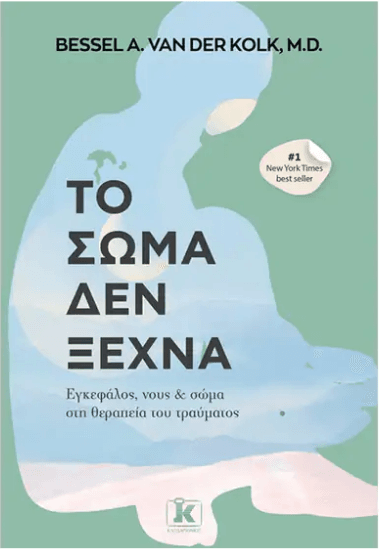Katerina Theodoraki and Kostas Batsalias
What is interesting about this book is its holistic approach. The author begins with a pharmacological approach to the mental illness of trauma, from which he himself originates, but transcends it and goes through trauma pathology in a multilevel and multifocal manner. He refers to the three approaches to trauma: 1) top down, 2) pharmacologically, and 3) bottom up, meaning from the body.
He describes his therapeutic experiences in an experiential manner.
The book reads like a story, like a narration of the author’s course through the hard paths of his traumatised patients’ stories. He constantly reflects, seeks the data, dares to exhibit his failures; his patients are his manual. He utilises his own experiences along with those of his patients, he experiments, he dares to demand a lot from therapy, to not be easily content, but to also not be easily disappointed. He constantly studies his patients with respect and learns from them.
The entire book is an anti-trauma manual, both in its style, and in its structure and organisation.
He describes many different approaches, which he recommends according to the specific features of every patient, without, however, categorising. He locates and adds methods and tactics beyond classic psychotherapy, as it is taught in clinical settings, universities and psychiatric hospitals, and he experiments with EMDR, Yoga, IFS, Neurofeedback, Theatre, and Somatotherapy. He knows and implements the truth of each patient’s singularity. He recognises that trauma does not only concern the individual that has experienced it, but the entirety of their environment, and spans from the past to the future intergenerationally.
He refers to the three new scientific disciplines - neuroscience, developmental psychopathology, and interpersonal neurobiology – and their findings.
He recognises that certain times, the symptoms of post-traumatic stress serve another role. They have a usefulness and a meaning for the person that experiences them, and if we only intervene with medication, the symptom disappears, but so does the meaning, leaving the person feeling dead, and deprived of a source of meaningfulness.
“The brain-disease model takes control over people’s fate out of their own hands and puts doctors and insurance companies in charge of fixing their problems”, he will state, questioning the overstressed effectiveness of antidepressants that did not result in a reduction of hospitalisation for depression. He will mention that the use of antipsychotics on children is socially defined. At the same time, he will attempt to document Developmental Trauma Disorder, utilising consensual diagnostic criteria, even though to his dismay, it was not included in DSM-5.
Also, the brain-disease model overlooks four fundamental truths. Relationships and their restoration, language and the communication of the experience, our ability to self-regulate, and finally the creation of suitable social conditions of security and prosperity.
“Being a patient rather than a participant in one’s healing process separates suffering people from their community and alienates them from an inner sense of self”.
Ultimately, neuroscience and the knowledge of the brain structures that are involved, are involuntarily leading us towards holistic approaches of therapies that connect the mind and the body.
As the author states in the book’s subtitle: “Brain, mind and body” are all involved in the healing of trauma. Perhaps, the additional element that he stresses and is interesting to us as therapists, is the participation of the body and the non-verbal, automatic processes and reactions. That is why it is worth reading!

